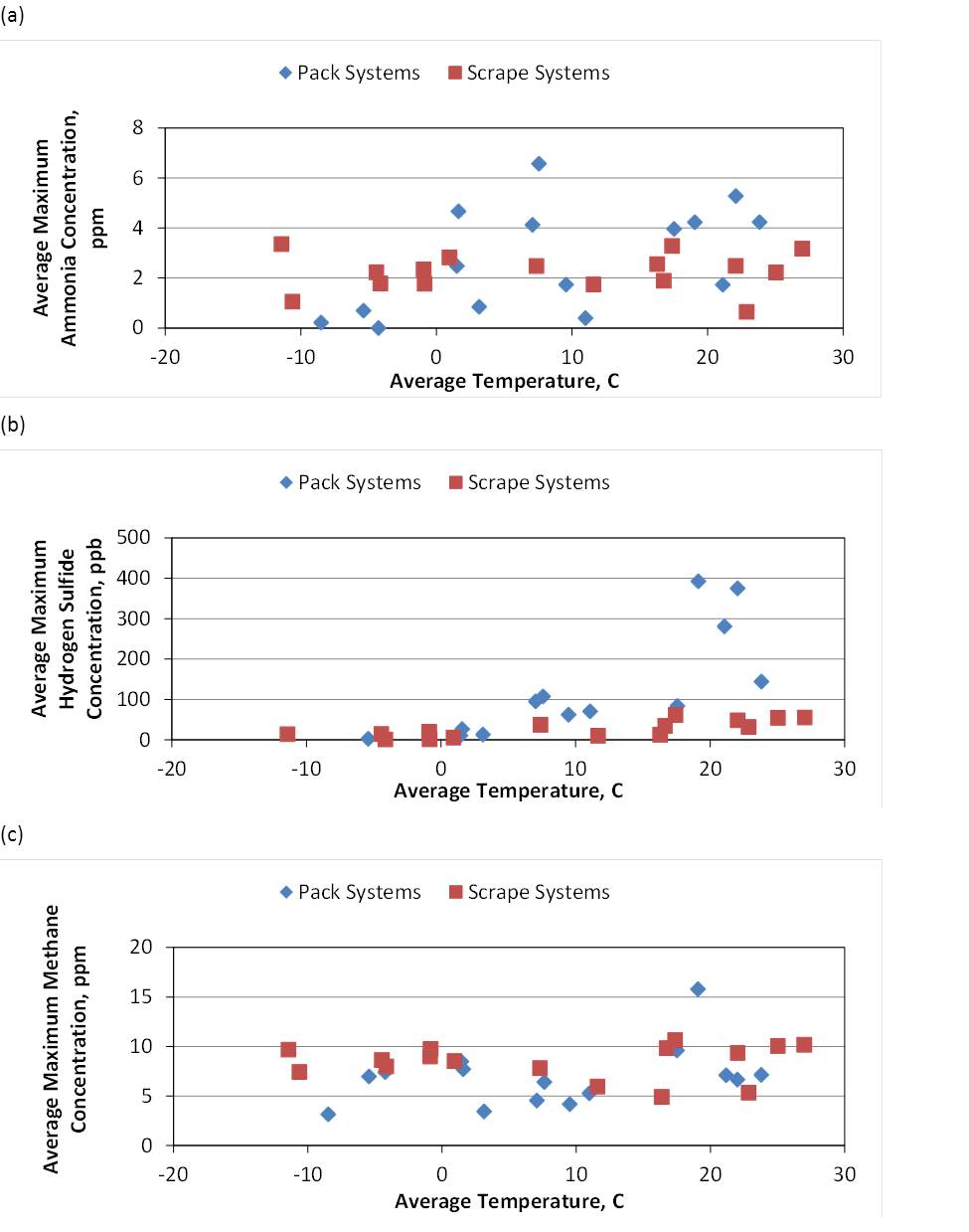This webinar goes beyond the farm gate and explores how manure and effluent nutrients are handled for some less-than-typical farm-raised animal species. This presentation was originally broadcast on January 17, 2020. More… Continue reading “Managing manure beyond the farmyard: Manure management for less-typical species and settings”
Watershed Nutrient Inventories – Opportunities and Needs
This webinar focuses on nitrogen and phosphorus inventories at two watershed scales, and how manure nutrients are incorporated. This presentation was originally broadcast on September 20, 2019. More… Continue reading “Watershed Nutrient Inventories – Opportunities and Needs”
Review of Odor Management Planning Templates and Calculators Across the US
Proceedings Home | W2W Home 
Purpose
Odor is a common and prevalent problem for new and existing livestock operations, and odor is often a source of conflict between neighbors. Odor cannot be removed in entirety from livestock production, but it can be managed. A few states have developed odor management plan guidelines or templates that may be mandatory, or voluntarily for the sake of good stewardship. Our long term goal is to construct an odor management plan template for South Dakota and beyond, and improve producer-neighbor relationships. Towards this goal, we present a review of established tools, templates and odor impact calculators that are in use in the United States.
What did we do?
We sent a questionnaire to four odor management plan (OMP) developers in Minnesota, Michigan, Nebraska and Pennsylvania. The questionnaire asked questions about the development process, users, marketing, and evaluation of odor management planning guides. We compared and contrasted the responses and identified opportunities to build on these past experiences elsewhere. Similarly, based on existing literature and online tools, four odor impact estimation calculators, or footprint tools were reviewed. These include the South Dakota Odor Footprint Tool, Odor From Feedlots Setback Emissions Tool (Minnesota), Odor Footprint Tool (Nebraska), and Purdue Odor Setback Model (Indiana).
What have we learned?
From the questionnaire it was clear that though an odor management plan is not a mandatory requirement in most of the states surveyed, the developers produced these guides for the betterment of the livestock industry of their state. During development of the OMPs, there was little exchange between producers, neighbors or policy makers collectively. Also, the use, evaluation and impact of the OMP templates was not tracked. There was not extensive marketing for the odor management plan guides aside from extension news updates and some presentations.
The pattern or format of the OMPs from the four different states was similar. Documentation of odor sources and record keeping of odor complaints was encouraged in all with a tabulated form. Michigan’s was the only guide to suggest quantitative estimation of odor impact, even though there are some nice and effective tools available to make these calculations for most states and regions. Odor monitoring was suggested in two states and one state suggested third party monitoring keep the assessment unbiased. Table 1 presents an overall review of questionnaire findings for the four states surveyed.
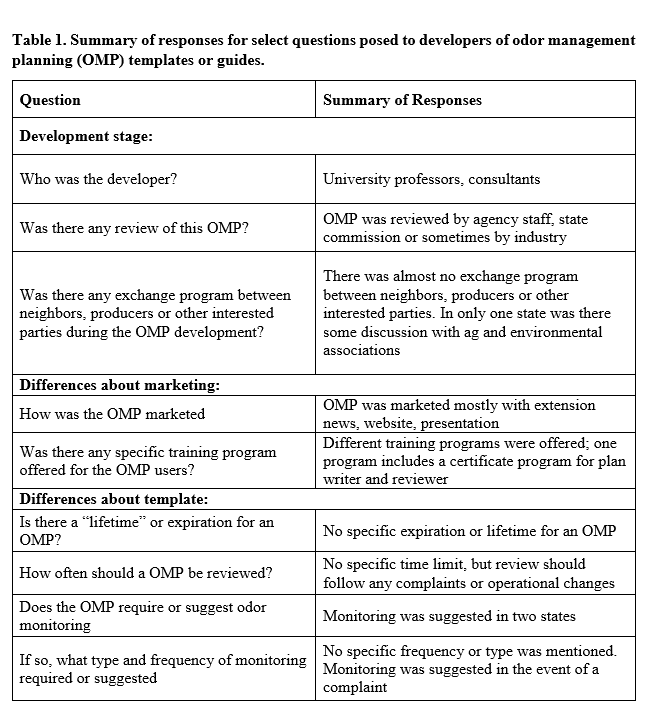
All four odor footprint tools were compared based on the odor emission estimates and dispersion model incorporation. Two of the tools considered terrain factors in odor dispersion calculations. Additional comparisons are shown in Table 2.

Future Plans
Building off of the feedback from OMP developers in other states, we plan to engage multiple interest groups in identifying the scope, use and dissemination of an OMP developed for South Dakota. There will be an emphasis on conflict resolution in the event of odor complaints so that odor complaints can be resolved locally (between neighbors) as much as possible.
Corresponding author, title, and affiliation
Suraiya Akter, Graduate Research Assistant, Agricultural and Biosystems Engineering, South Dakota State University
Corresponding author email
Other authors
Erin Cortus, Associate Professor and Environmental Quality Engineer, Agricultural and Biosystems Engineering, South Dakota State University
Additional information
Acknowledgements
We would like to thank Dr. Jerry May (MSU), Mr. David Schmidt (UMN), Mr. Karl Dymond (Pennsylvania State), Dr. Richard Koelsh (UNL) for their kind response to the questionnaire.
The Pathways Project
Why Examine Learning Pathways in Nutrient Management?
During the 2013 Waste to Worth Conference, a session on “Nutrient Management Standards: Making Them Work Where We Work” sparked discussion on the need to match manure nutrient management (and other related topic) tools and content with the end user. This discussion also highlighted organization and institutional language barriers that also challenge information transfer among users.
Technology has opened up new communication lines between various groups, but unless we can speak the same language and recognize the goals and needs between groups, establishing effective partnerships is difficult. Furthermore, the potential and realized reach through outreach methods available to different groups is not well understood.
A map of the pathway between information producers (i.e., researchers) and users is vital, along with the identification of end user format and language necessary for comprehension and usefulness. By providing a pathway to audience types and needs, research groups can realistically identify the target groups for their specific project outcomes and produce targeted products, information sources, and formats for those end users. In addition, this hierarchal pathway allows researchers to select project partners from specific agencies and industries in their Region to communicate directly with in order to produce a tailored and more impactful product.
What did we do?
A national team of Researchers, Extension specialists, Consultants and Government Staff came together with the overall objectives to: (1) document effective information transmission methods, pathways, and formats for different audience types; and (2) demonstrate a hierarchal approach of information dissemination through various audience types. Based on input and guidance from the national team, an electronic survey was developed to quantify and qualify information source (inputs), information products or sharing mechanisms (outputs), and collaborations (existing links) between organization types. The survey also qualifies the barriers to information flow between organizations and individuals regarding manure nutrient management.
A pilot test of the survey was conducted in 2014 in South Dakota. Based on the results of that project, minor refinements were made to the survey, which is being distributed nationally in the Spring of 2015. The electronic survey is being disseminated via cooperating agencies, organizations and personal contacts to technical service providers, producers, university personnel, regulatory personnel, private sales or service enterprises and other professionals who contribute to manure nutrient management.
What have we learned?
The South Dakota pilot project gave us a peak into the viability and potential impact this national survey can have. We were able to infer important connections and barriers that will lead to very important modifications to information transfer in the future. The collaboration and input from the national team members has been critical to the development and vetting of the survey tool. Through this team, organizational language differences have emerged. Over time, we look to document these terms for future reference to a broader audience.
Future plans
The results of the national survey will be analyzed in the Summer of 2015. In the Fall of 2015, the exercise of documenting pathways based on the survey data will be conducted with a focus on data collected for the North Central Region. A similar process will be followed for other regions of the country. An intended outcome of this project is the creation of a reference document/tool and process that enables integrated research projects to identify a vetted method for successful dissemination of research results to the correct target audiences in the most impactful formats.
Authors
Erin Cortus, Assistant Professor and Environmental Quality Engineer, Agricultural and Biosystems Engineering, South Dakota State University, erin.cortus@sdstate.edu
Nichole Embertson, Nutrient Management Specialist, Sustainable Livestock Production Program, Whatcom Conservation District, NEmbertson@whatcomcd.org
Additional information
Key contributors for the North Central Region are Teng Lim (University of Missouri), Amy Schmidt (University of Nebraska-Lincoln), and Jill Heemstra (University of Nebraska-Lincoln).
Acknowledgements
The nationwide team who contribute to and guide the Pathways project are gratefully acknowledged. Funding provided through the South Dakota SARE Mini-Grant Program supported data collection and analysis for the survey pilot test. The North Central Region Water Network provided funding for analysis and dissemination of data collected for the North Central Region.
The authors are solely responsible for the content of these proceedings. The technical information does not necessarily reflect the official position of the sponsoring agencies or institutions represented by planning committee members, and inclusion and distribution herein does not constitute an endorsement of views expressed by the same. Printed materials included herein are not refereed publications. Citations should appear as follows. EXAMPLE: Authors. 2015. Title of presentation. Waste to Worth: Spreading Science and Solutions. Seattle, WA. March 31-April 3, 2015. URL of this page. Accessed on: today’s date.
Modeling water movement in beef cattle bedded manure pack
Why Examine Moisture Content of a Manure Pack?
Bedded manure is a valuable fertilizer source because it contains essential macronutrients (nitrogen (N), phosphorus (P), and potassium (K)) for crop production. Previous research with beef cattle bedded manure packs demonstrated that water-soluble macronutrients accumulated toward the bottom of the packs with water movement. Thus, predicting water movement in bedded manure helps to estimate nutrient composition throughout the bedded pack. This work presents a development of a process-based model of vertical water movement that considers percolation and diffusion as the main processes of water and vapor movements in bedded manure packs. Evaporation from the top zone to the atmosphere was considered a process of convective mass transfer. The model predicts the change in moisture content of the different zones in the bedded manure and assists in estimating nutrient composition.
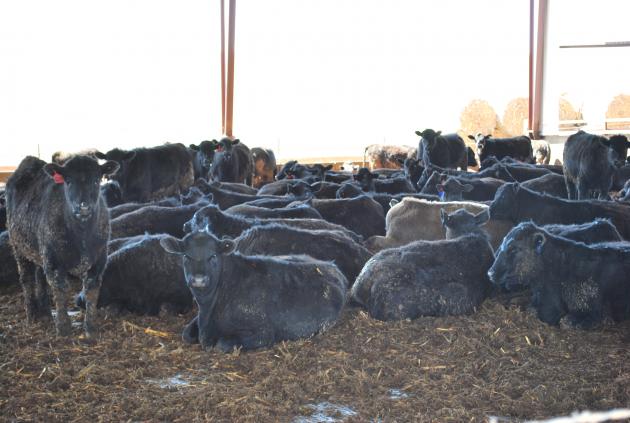 Why Study Moisture Movement In a Bedded Pack?
Why Study Moisture Movement In a Bedded Pack?
Beef cattle producers that raise cattle in complete confinement, such as mono-slope or hoop barns, may apply bedding material to manage moisture and improve the environment for the animals. Some producers let the manure and bedding accumulate to form a bedded manure pack, which is compacted by cattle activity. The bedded manure contains valuable nitrogen (N), phosphorus (P), and potassium (K) that are essential for crop production and soil sustainability. Depending on temperature, bedding material, and storage time of the bedded pack, the concentration of water-soluble N, P and K compounds may increase in the bottom of the bedded pack where water accumulates. Thus, understanding and predicting water movements within the bedded manure is important to estimate fertilizer N-P-K content and distribution in the bedded manure.
What did we do?
The processes considered in this process-based model include evaporation, percolation, diffusion of water vapor and diffusion of liquid water for vertical water movement. The model by Seng et al. (2012) for static compost piles and a modified version of the Integrated Farm System Model (not yet released) by Rotz et al. (2014) for bedded manure were reviewed and compared. Ultimately, the model needs to be adaptable to estimate the water content of the pack over time for different environmental conditions, bedding materials, and storage times at varying depths within the bedded pack. Data for model calibration and validation were gained through laboratory-scale experiments by Ayadi et al. (in review).
What have we learned?
Percolation and liquid water diffusion are considered the main processes for vertical water movement between layers in the bedded manure. Evaporation occurs from the surface of the top zone of the bedded pack. The rates of percolation and liquid water diffusion are depth-specific and their rates therefore vary. The modified version of the Integrated Farm System Model (IFSM) is more adaptable to data gained through laboratory-scale experiments. Overall, IFSM is more applicable to producer-available data and thus more applicable to predict water movement for bedded manure packs in real-life conditions.
Future Plans
After predicting water movements in the bedded manure, the model will be used to estimate N, P and K movement through the different zones of the bedded manure pack as well as gaseous emission (ammonia and nitrous oxide) from the bedded pack surface. The final overall model will be a calculator that estimates fertilizer N-P-K content and value and ammonia and nitrous oxide emissions of the bedded manure packs from confined beef cattle facilities with respect to temperature, bedding material, storage time and depth of the bedded pack.
Authors
Erin Cortus, Ph. D., Assistant Professor, South Dakota State University, Brookings, SD
Ferouz Ayadi, M.S., Graduate Student, South Dakota State University, Brookings, SD; Mindy Spiehs, Ph. D., Animal Scientist, USDA‐ARS Meat Animal Research Center, Clay Center, NE
Additional information
References
Ayadi, F. Y., M. J. Spiehs, E. L. Cortus, and D. N. Miller. In review. Physical, chemical and biological properties of different depths and ages of simulated beef bedded manure packs. Transactions of the ASABE.
Rotz, C.A., Corson, M.S., Chianese, D.S., Montes, F., Hafner, S.D., Bonifacio, H.F., Coiner, C.U., 2013a.
The Integrated Farm System Model Reference Manual, Version 4.1. USDA-Agricultural Research Service. Avaialble at: http://www.ars.usda.gov/sp2UserFiles/Place/80700500/Reference%20Manual.pdf
Seng, B., H. Kaneko, K. Hirayama, and K. Katayama-Hirayama. 2012. Development of water movement model as a module of moisture content simulation in static pile composting. Environmental Technology 33(15):1685-1694.
Acknowledgements
The support and assistance of Henry F. Bonifacio with the simulation of water movements in the bedded pack manure is very much appreciated. This project and all associated reports and support materials were supported by the Sustainable Agriculture Research and Education (SARE) program, which is funded by the U.S. Department of Agriculture- National Institute of Food and Agriculture (USDA-NIFA). Any opinions, findings, conclusions or recommendations expressed within do not necessarily reflect the view of the SARE program or the U.S. Department of Agriculture. USDA is an equal opportunity provider and employer. The mention of trade names or commercial products in this publication is solely for the purpose of providing specific information and does not imply recommendation or endorsement by the USDA.
The authors are solely responsible for the content of these proceedings. The technical information does not necessarily reflect the official position of the sponsoring agencies or institutions represented by planning committee members, and inclusion and distribution herein does not constitute an endorsement of views expressed by the same. Printed materials included herein are not refereed publications. Citations should appear as follows. EXAMPLE: Authors. 2015. Title of presentation. Waste to Worth: Spreading Science and Solutions. Seattle, WA. March 31-April 3, 2015. URL of this page. Accessed on: today’s date.
Nutrient Management Standards – Making Them Work Where We Work
![]() Waste to Worth home | More proceedings….
Waste to Worth home | More proceedings….
Abstract
The economics and environmental impacts of livestock production cross watershed boundaries and affects both rural and urban populations. In particular, the issue of manure management has been the subject of debate and new policies in recent years as the non-point source discharge of nutrients and bacteria can be substantial if manure is not managed properly. Like most policies and rules, every five years the National Conservation Practice Standard (590) on Nutrient Management undergoes review and revision. This year, 2013, marks the initial year for adoption and implementation of state-specific and/or revised 590 standards across the United States. Despite “guiding” national standards and policies, there are different, unique approaches and tools used for nutrient management within different states and regions.
Why Discuss Nutrient Management Standards?
This session explores how different states are moving forward with nutrient management policies, standards and practices, and in particular, related to the NRCS 590 Standard. This session will include a panel discussion on unique adaptations by states to phosphorus indices, nitrogen leaching indices, winter application guidelines, air quality, and general nutrient management planning. The panel will also discuss if and how stakeholders have come together to develop these standards and practices. The discussion is also open to audience members wishing to share approaches and ideas. The session will conclude with a planning session to identify how we can, cooperatively, prepare for future policy and standard development, including discussion of collaborative research opportunities. This is a great opportunity to start building multi-state research projects to provide answers to manure management questions and issues that we might face in another five years.
Presenters
Erin Cortus, Assistant Professor, South Dakota State University erin.cortus@sdstate.edu and Nichole Embertson, Nutrient Management and Air Quality Specialist, Whatcom Conservation District, Lynden, Washington nembertson@whatcomcd.org
All presenters were invited to speak on the panel as experts on their State’s 590 revisions and/or adoption and implementation process. Their unique perspectives and processes will shed light on the regional differences in Nutrient Management and how it is affected by policy, social considerations, and regional resource concerns.
Laura Pepple, Livestock Extension Specialist, University of Illinois Urbana-Champaign
Melony Wilson, Animal and Dairy Science Public Service Representative, University of Georgia
Bonda Habets, Certified Crop Advisor, Washington State
James Sharkoff, State Conservation Agronomist, USDA-NRCS Colorado State
Handouts
Summary of Responses from National Survey
The authors are solely responsible for the content of these proceedings. The technical information does not necessarily reflect the official position of the sponsoring agencies or institutions represented by planning committee members, and inclusion and distribution herein does not constitute an endorsement of views expressed by the same. Printed materials included herein are not refereed publications. Citations should appear as follows. EXAMPLE: Authors. 2013. Title of presentation. Waste to Worth: Spreading Science and Solutions. Denver, CO. April 1-5, 2013. URL of this page. Accessed on: today’s date.
Manure management and temperature impacts on gas concentrations in mono-slope cattle facilities
![]() Waste to Worth home | More proceedings….
Waste to Worth home | More proceedings….
Why Study Air Emissions from Mono-slope Beef Barns?
Mono-slope buildings (Figure 1) are one type of roofed and confined cattle feeding facility that is becoming increasingly popular in the Northern Great Plains. However, little is known about the impact of these housing systems and associated manure management methods on the air quality inside and outside the barn. The objective of this study was to determine gas concentrations in mono-slope beef cattle facilities and relate these concentrations to environmental and manure management factors.
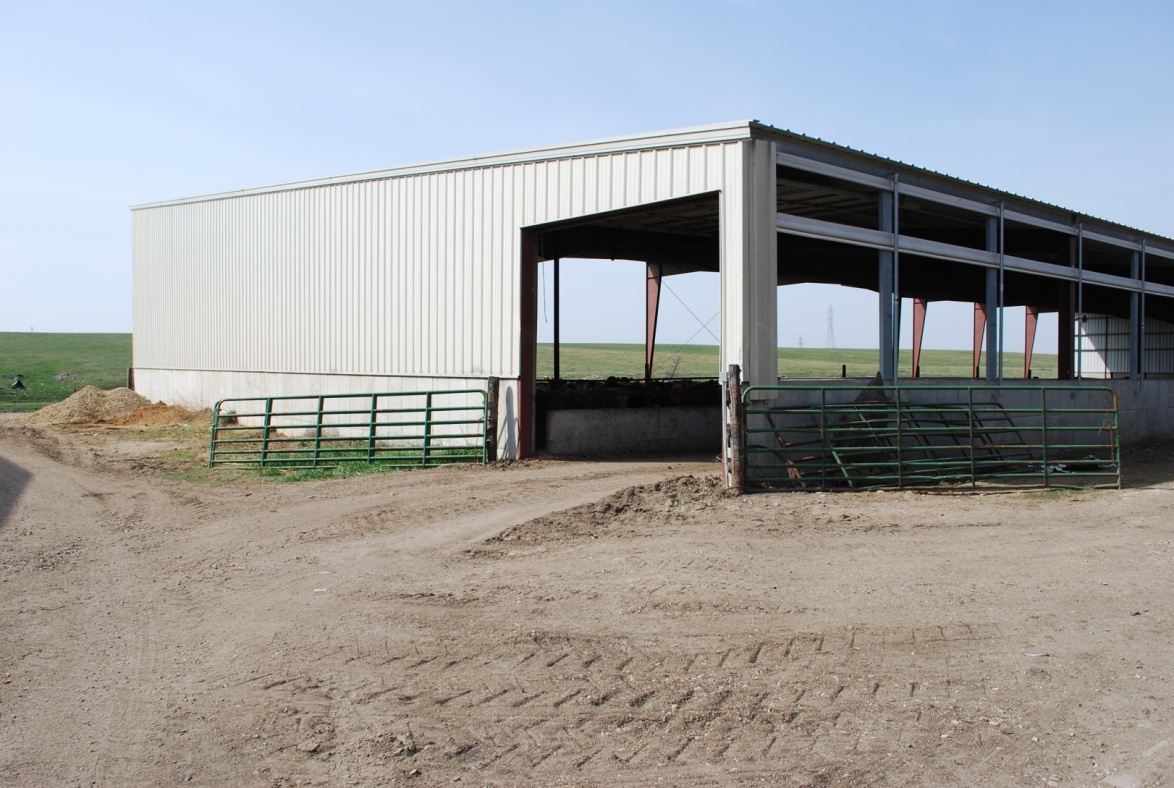 |
| Figure 1. View of a monoslope cattle facility from the northeast. Adjustable curtains in the rear (north) wall are used to limit airspeed through the barn during colder weather. |
What Did We Do?
Four producer-owned and operated beef deep-bedded mono-slope facilities were selected for monitoring. Two barns maintained deep-bedded manure packs (Bedpack), whereas two barns scraped manure and bedding from the pens weekly (Scrape). Each site was monitored continuously for one month each quarter for two years to capture both daily and seasonal variations. At each facility, the environment-controlled instrument trailer and associated equipment were located adjacent to the barn. The trailer contained: a gas sampling system (GSS) that consisted of Teflon tube sample lines connected to a computer-controlled sampling manifold, gas analyzers, computer, data acquisition system, calibration gas cylinders, and other supplies. In addition to the sampling lines, there were environmental instruments to measure the airflow and weather conditions for two pens in each barn. The analyzers and sensors used are summarized in Table 1.
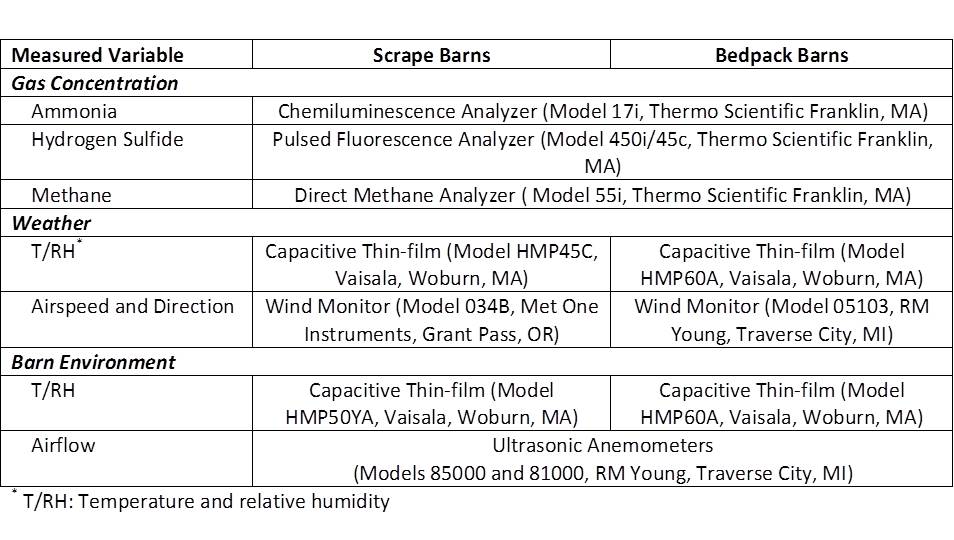 |
|
|
Ammonia, hydrogen sulfide and methane concentrations were sequentially sampled from two south wall locations and three north wall locations per pen. The maximum hourly mean concentrations measured at the north or south wall of either pen in the barn were used in this analysis. The seasonal average hourly means of maximum concentrations and corresponding environmental variables were calculated.
What Have We Learned?
The seasonal average hourly maximum ammonia concentration ranged from 0.6 to 3.3 ppm with the Scrape barns and from 0.2 to 7.1 ppm with the Bedpack barns (Fig 2a). The range of maximum hydrogen sulfide concentrations was 0 to 61 ppb in the Scrape barns and 0 to 392 ppb in the Bedpack barns (Fig 2b). The maximum methane concentration ranges were 4.9 to 10.6 and 3.1 to 15.8 ppm in the Scrape and Bedpack barns, respectively (Fig 2c). There are indications of differences between gas release rates for bedpack and scrape manure management systems and increased release rates with temperature for ammonia and hydrogen sulfide. Methane concentrations were more consistent between systems and for different temperature conditions.
This project expands the knowledge base of gaseous concentrations from deep-bedded beef barns. This integrated project also provides management techniques that producers can implement to minimize emissions, and improve air quality.
Future Plans
Emission values will be calculated using these concentration data, in conjunction with airflow data, which also varies with site and temperature conditions.
Authors
Erin L. Cortus, Assistant Professor, South Dakota State University, erin.cortus@sdstate.edu
Md Rajibul Al Mamun, Graduate Research Assistant, South Dakota State University
Ferouz Y. Ayadi, Graduate Research Assistant, South Dakota State University
Mindy J. Spiehs, Research Animal Scientist, USDA ARS Meat Animal Research Center
Stephen Pohl, Professor, South Dakota State University
Beth E. Doran, Extension Beef Program Specialist, Iowa State University Extension and Outreach
Kris Kohl, Extension Ag Engineer Program Specialist, Iowa State University Extension and Outreach
Scott Cortus, Engineering Research Technician, South Dakota State University
Richard Nicolai, Associate Professor (Retired), South Dakota State University
Additional Information
- Mono-slope air quality research project website
- Design and management of mono-slope barns (archived webcast)
- Introduction to mono-slope cattle facilities
Acknowledgements
Project funded by Agriculture and Food Research Initiative Competitive Grant no. 2010-85112-20510 from the USDA National Institute of Food and Agriculture. Technical assistance provided by Alan Kruger, John Holman, Todd Boman, and Bryan Woodbury.
The authors are solely responsible for the content of these proceedings. The technical information does not necessarily reflect the official position of the sponsoring agencies or institutions represented by planning committee members, and inclusion and distribution herein does not constitute an endorsement of views expressed by the same. Printed materials included herein are not refereed publications. Citations should appear as follows. EXAMPLE: Authors. 2013. Title of presentation. Waste to Worth: Spreading Science and Solutions. Denver, CO. April 1-5, 2013. URL of this page. Accessed on: today’s date.
Mono-Slope Beef Barn Air Quality Research Project
 Researchers and university specialists from USDA’s Meat Animal Research Center (USMARC), South Dakota State University, and Iowa State University recently finished a four-year study looking at mono-slope beef barns and how to improve cattle and environmental performance.
Researchers and university specialists from USDA’s Meat Animal Research Center (USMARC), South Dakota State University, and Iowa State University recently finished a four-year study looking at mono-slope beef barns and how to improve cattle and environmental performance.
How Do Mono-slope Barns Stack Up For Air Quality?
A research team worked for three years to gather baseline data for the levels of gas emissions from mono-slope beef barns. The study involved a total of four mono-slope beef barns in South Dakota and Iowa. Researchers also evaluated two different manure-handling systems to determine if there are any differences in gas emissions.
The results of that study are summarized in a eight-page publication “Air Quality in Mono-Slope Bedded Beef Barns“. They measured ammonia, hydrogen sulfide, methane, carbon dioxide, and nitrous oxide. The first three are the primary focus of the publication, since those are most commonly associated with beef feedlots. Also discussed are impacts of building orientation, manure-handling system, pen density, bedding type, and curtain opening (ventilation).
Beef Facilities Conference
Over 300 people attended the November, 2013 conference on beef confinement buildings held in Sioux Falls, South Dakota. The recordings and written papers are linked below.
Environmental and Regulatory Aspects of Beef Barns
The page numbers next to each are the location of companion written papers in the Beef Facilities Conference proceedings.
- Results of Air Quality Research on Mono-slope Bedded Beef Barns – pages 5-9.
- Air Quality Regulations and implications of the air quality research project – pages 10-17
The third presentation focuses on manure and nutrient production, and nutrient management for manure produced in these systems.
- Capturing, managing, and using nutrients from the barn – pages 18-21
Producer Panel – Virtual Tours
Four producers shared aspects of their different building designs including ventilation, manure management, what works well, and things they would change. Their summaries are on pages 22-26 of the Beef Facilities Conference Proceedings.
- Hoop buildings – one farm tour and a short synopsis of different building designs in use in Iowa
- Mono-slope buildings – narrow and wide designs
- Slatted floor barn (with rubber mats) – originally built without mats
Cattle Performance and Comfort In Beef Barns
University specialists compared feed intake, animal performance, carcass characteristics, and management considerations with barns compared to other systems. The page numbers next to each are the location of a companion written paper in the Beef Facilities Conference Proceedings.
- Comparing open lots, partially covered lots, and bedded mono-slope facilities – pages 27-29
- Comparing hoop barns and a semi-confinement facility- pages 30-32
The third presentation looks at international and domestic research into the use of rubber mats in deep pit barns with concrete slats.
- Rubber mats compared to uncovered concrete slats in deep pit beef barns – pages 33-37
Webcasts
Two live webinars were recorded and archived. The presenters included researchers, extension specialists, and farmers.
- Mono-Slope Beef Barn Design and Management – Basics on the design of barns and “virtual tours” from two farmers who utilize these in their beef production systems.
- Results of the Mono-slope Beef Barn Air Quality Research Project – This webinar was the first of several resources on this page discussing the results of the multi-year, multi-state research into the air emissions. | Related: PDF publication Air Quality in Mono-Slope Bedded Beef Barns | Beef Facilities Conference recordings | Waste to worth conference proceedings
Open Houses Provide Opportunities to Learn More
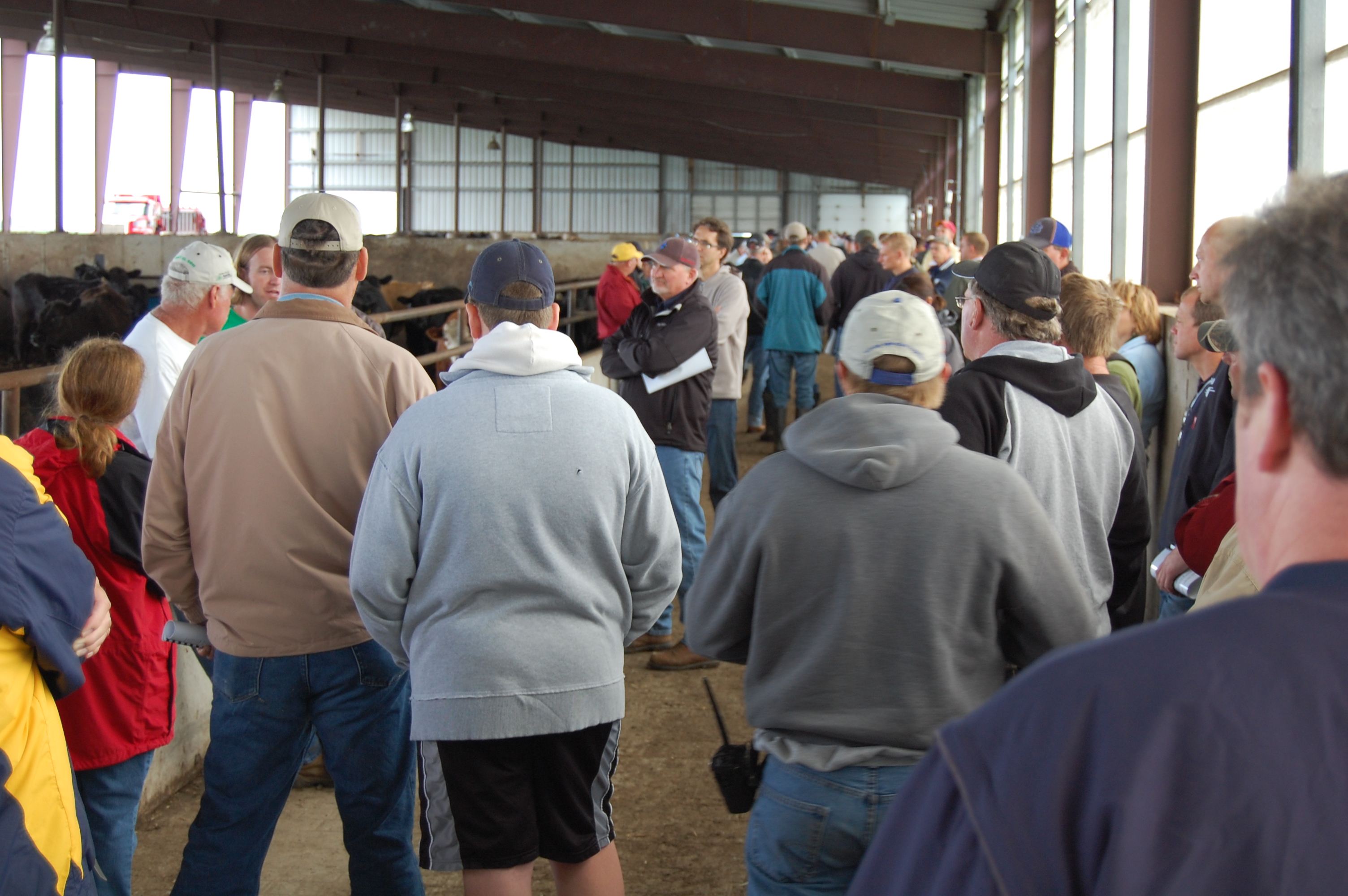 |
| It was standing room only as participants listened to station presentations in the alleyway of the mono-slope barn. |
As part of the outreach plan for this project, a series of open houses were scheduled to inform cattle producers, regulatory and technical agency staff, Extension employees, service providers and legislative and local policy-makers about air quality management and manure and environmental issues with these facilities.
Over 200 people from Iowa, Minnesota, South Dakota and Nebraska attended the Mono-Slope Beef Barn Open House in June of 2011. The open house was hosted by Ron and Clayton Christensen of Royal, Iowa and featured barn and manure management, cost-sharing opportunities, the tri-state air quality project and environmental regulations.
The open house was organized by ISU Extension and Outreach, SDSU Ag and Biosystems Engineering, and the USDA Meat Animal Research Center at Clay Center, NE. Sponsors included Animal Medical Centers of Spencer, Clay County Cattlemen’s Association, Clay County Farm Bureau, Coalition to Support Iowa’s Farmers, Farm Credit Services of America -Emmetsburg, Spencer Ag Center and Spencer Chamber of Commerce Ag Committee.
A second open house was hosted in South Dakota in August of 2011. The open house was hosted by Goodwin Heritage Cattle Company, with approximately 125 people in attendance from South Dakota and neighboring states. Sponsors included Coteau Hills Cattlemen’s Association, Watertown Chamber of Commerce Ag Committee, SPN & Associates, Glacial Lakes Energy LLC., Landmark Builders Inc., South Dakota Farm Bureau, Ag United for South Dakota, Banner Associates and Form-A-Feed, Inc.
As a result of the two open houses:
- 95% had a better understanding of the air quality regulations and why this research is needed*
- 88% learned where they could find financial resources to construct a mono-slope barn*
- 89% had improved knowledge about how gases and dust are measured*
*Based on 19.7% participation in a short survey after each open house
Learn more about the successes of these open houses.
A facility tour, Science Behind Environmental Policy, was held June 22, 2012 in NW Iowa. This tour was attended by state and federal legislators, state policy makers and stakeholders representing Extension and university specialists. Enthusiasm for research efforts was proclaimed by the legislators. See what they learned.
NW Iowa cattlemen listened to Mindy Spiehs, researcher with USDA ARS Meat Animal Research Center at Clay Center, share progress about the Tri-State Air Quality Project. The update and tour at the Christensen barn were part of a NW regional meeting sponsored by the Iowa Cattlemen’s Association on August 23, 2012.
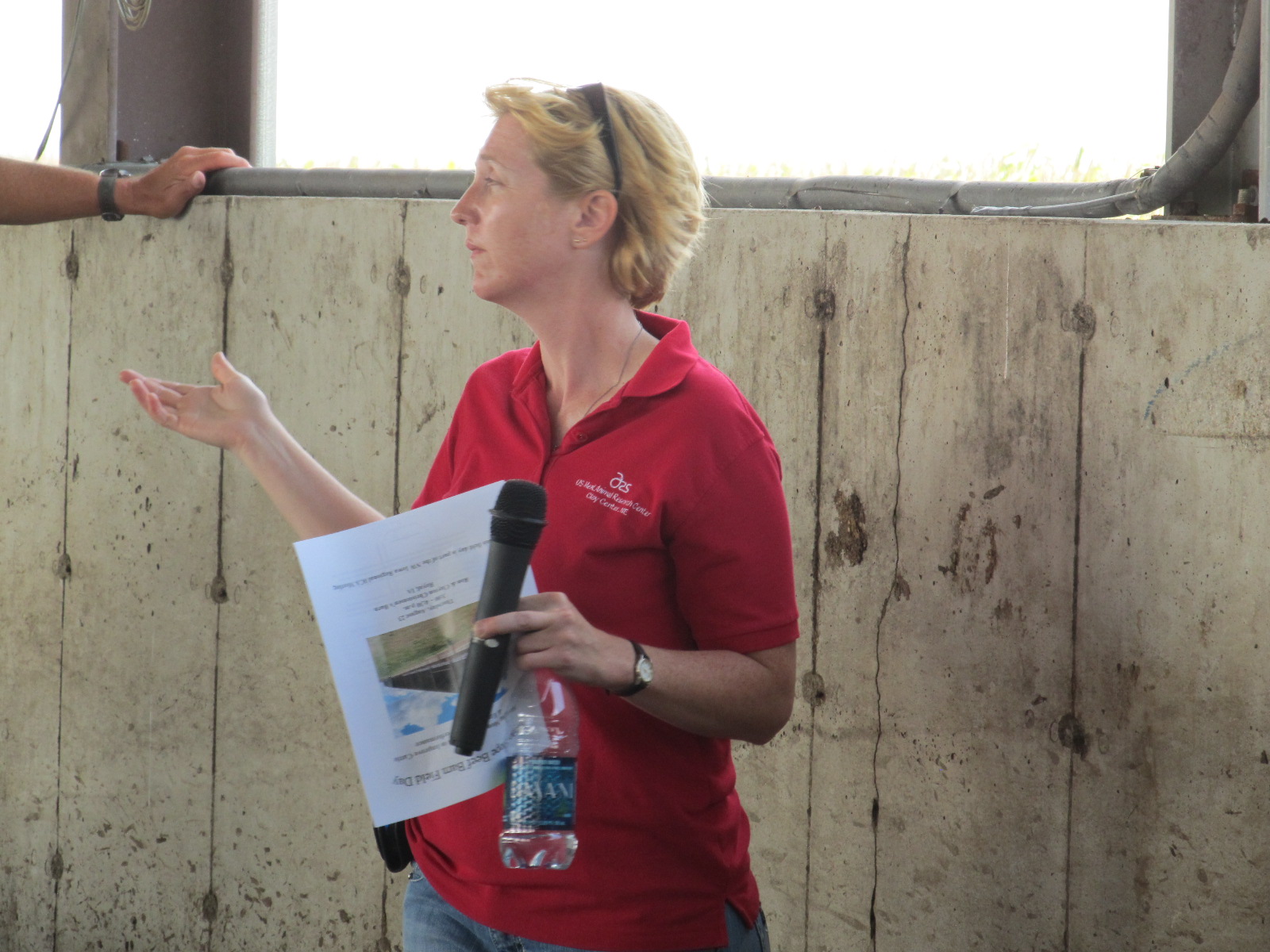 |
| Mindy Spiehs talks about the Tri-State Air Quality Project. |
Waste to Worth Conference Presentations
In April, 2013 researchers presented air emissions results from this project at the Waste to Worth: Spreading Science and Solutions conference in Denver, CO. These proceedings include a short written paper, recording and links to additional information. The different aspects presented were:
- Manure management and temperature impacts (Cortus)
- Ammonia and greenhouse gases (Ayadi)
- Particulate matter (Spiehs)
The above proceedings compliment the Beef Facilities Conference recordings and webcasts on the research project (both further up on this page).
Acknowledgements
This page was developed as a part of the Monoslope Beef Barn Air Quality Research project that was funded by Agriculture and Food Research Initiative Competitive Grant no. 2010-85112-20510 awarded to South Dakota State University, USDA ARS U.S. Meat Animal Research Center, Iowa State University, and University of Nebraska – Lincoln from the USDA National Institute of Food and Agriculture. For more information about the research study, contact Erin Cortus erin.cortus@sdstate.edu or Mindy Spiehs mindy.spiehs@ars.usda.gov. For more about the outreach and extension, contact Beth Doran doranb@iastate.edu.

Mono-Slope Beef Barns
There is growing interest in feeding cattle in bedded confinement buildings for a multitude of reasons including (but not limited to): performance advantages, limited space for open lots, and keeping manure dry as well as preventing feedlot run-off and reducing environmental concerns. Oftentimes these confined cattle are housed in mono-slope barns.
What Is a Monoslope Beef Barn?
This video is excerpted from a webcast presentation by Shawn Shouse, Iowa State University
Mono-slope barns, by definition have only one slope to their roof and are usually naturally ventilated. They are typically positioned to take advantage of seasonal climatic conditions. This means in the northern hemisphere the higher side would be south-facing with the lower side to the north. This allows for shade in the summer and sun exposure in the winter. In bedded units, the bedding absorbs moisture and provides a softer surface for cattle to walk and lay on.
Comparing Confinement Farms with Conventional Feedlots
| Shawn Shouse of Iowa State University compares confinement systems to open lots for beef cattle. |
While there are many advantages to mono-slope beef barns, the question that has been raised is: “What is the quality of air in these barns?”. A recent, on-going research project takes on this question.
Recommended Reading
- Beef Facilities Conference – November 21, 2013
- Monoslope Research Project
- Climate Conditions in Bedded Confinement Buildings
- Beef Feedlot Systems Manual (ISU)
- A Survey of Manure Characteristics from Bedded Confinement Buildings for Feedlot Beef Production – Progress Report (ISU)
- A Survey of Manure Characteristics from Bedded Confinement Buildings for Feedlot Beef Production – Final Report (ISU)
- Fed Cattle Performance in Open Lots and Bedded Confinements (ISU)
- Environmental Conditions in Beef Deep-Bedded Mono-Slope Facilities (ISU)
- Hoops and Mono-Slopes: What Have We Learned About Management and Performance (pp 8-17) in Feedlot Forum 2010 Proceedings (ISU)
- Errata Sheet for Hoops and Mono-Slopes: What Have We Learned About Management and Performance (ISU)
- MWPS Publication on Cattle Feeding Buildings in the Midwest (MWPS)
- Opportunities Farm Feedlot Information (SDSU)
- Opportunities Farm Update
- Technical Note on Beef and Dairy Bedded Pack Barn Planning and Design
- Spreadsheet for calculating manure storage space in bedded pack barns
- Fed Cattle Performance in Open Lots and Bedded Confinements
Webcasts
- Mono-Slope Beef Barn Design and Management Webcast
- Results of the Mono-slope Beef Barn Research Project
Inquiries about the mono-slope barns may be directed to:
— Beth Doran, Iowa State University (phone: 712-737-4230)
— Kris Kohl, Iowa State University (phone: 712-732-5056)
— Erin Cortus, South Dakota State University (phone: 605-688-5141)
— Mindy Spiehs, U.S. Meat Animal Research Center (phone: 402-762-4271)
This page was developed as a part of the Monoslope Research project that was funded by Agriculture and Food Research Initiative Competitive Grant no. 2010-85112-20510 awarded to South Dakota State University, USDA ARS U.S. Meat Animal Research Center, Iowa State University, and University of Nebraska – Lincoln from the USDA National Institute of Food and Agriculture.

Reaching the Next Generation Through Fun and Interactive Activities
This webinar shares ideas and activities that have been used with youth across the country on manure, air quality, and sustainability. This presentation was originally broadcast on December 12, 2014. More… Continue reading “Reaching the Next Generation Through Fun and Interactive Activities”


